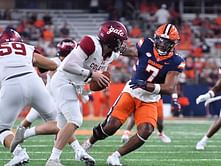
Kinnick Stadium, found in Iowa City, Iowa, is the proud home of the University of Iowa Hawkeyes football team. Originally named Iowa Stadium, it opened its doors in 1929 to replace Iowa Field. Today, Kinnick Stadium can host up to 69,250 people, making it the 7th largest stadium in the Big Ten and one of the nation's top 20 university-owned stadiums. Its capacity has remained at 69,250 since 2018.
Kinnick Stadium History and Construction Cost
Kinnick Stadium, the pride of Iowa City, has a rich history and an economical construction story. Originally named Iowa Stadium, this iconic venue was built in approximately seven months, from 1928 to 1929. Construction kicked off on March 6, 1929, with workers laboring day and night, aided by horses and mules, and lit by night.
There's a longstanding rumor that horses that passed away during construction were buried under what's now the North end zone. However, historians debunk this, stating that the animals were actually disposed of in the nearby Iowa River. Despite challenges like the athletic director's resignation and minor redesigns, the stadium was completed by July. Its first game, played on October 5, 1929, against Monmouth College, saw Iowa winning 46–0. The official dedication occurred two weeks later when the Hawkeyes tied Illinois 7–7.
Remarkably, the initial construction cost was just $497,151.42, equivalent to $8.47 million in 2022 dollars, making Kinnick Stadium an economic marvel. In terms of history and value, Kinnick Stadium stands tall.
Kinnick Stadium Capacity
Kinnick Stadium, managed by the University of Iowa, has a current capacity of 69,250 spectators, which it has maintained since 2018. The playing surface at Kinnick Stadium is FieldTurf, which has been used since 2009. It's a stadium where fans can enjoy thrilling football action in a modern and comfortable setting, with plenty of room for cheering on their favorite team.
Kinnick Stadium Seating Chart
Kinnick Stadium's seating chart is thoughtfully designed to enhance the fan experience. Each sideline section comprises 79 rows of seating, and entry tunnels are conveniently situated around row 42. The visitor's side (Sections 101-110) is exposed to direct sunlight and the elements. To avoid the sun's glare, consider rows 60 and above in sections 123-130 on the Iowa side. For an outstanding view, choose seats near Row 35 on both sides, near the concourse tunnel. Sections 122 and 123 are reserved for Iowa students, while Sections 101 and 102 are designated for visiting fans. Enjoy the game in comfort!
What to Bring to Kinnick Stadium?
When attending a game at Kinnick Stadium, it's essential to be prepared. Here's what to bring:
Identification: Ensure you have a photo ID, like a driver's license or credit card, as a deposit may be required.
Accessibility Aids: Feel free to bring mobility devices such as canes, crutches, walkers, wheelchairs, or scooters into Kinnick Stadium.
Closed Captioning: For an inclusive experience, closed captioning is available on the south video board.
Bag Policy: Kinnick Stadium has a clear bag policy. Approved bags include clear ones no larger than 12" x 6" x 12", one-gallon clear plastic bags, or small clutch bags not exceeding 4.5" x 6.5". Adhering to this policy makes entry smooth and easy.
Parking Cost at Kinnick Stadium
Parking at Kinnick Stadium can be a challenge due to its popularity. On-site parking is limited and primarily reserved for season ticket holders and donors. However, off-site parking options are available, including nearby lots and garages. It's advisable to arrive early, consider using public transportation, or explore pre-paid parking options to ensure a hassle-free experience. Be prepared to walk a bit, but the excitement of the game at Kinnick Stadium makes it all worthwhile.

FAQs on Kinnick Stadium
A: Kinnick Stadium has a capacity of 69,250 seats.
A: The stadium is located at 825 Stadium Drive, Iowa City, IA 52240, USA.
A: Kinnick Stadium, originally named Iowa Stadium, opened in 1929.
A: Kinnick Stadium enforces a clear bag policy, allowing clear bags no larger than 12" x 6" x 12", one-gallon clear plastic bags, or small clutch bags no bigger than 4.5" x 6.5".
A: The initial construction cost of Kinnick Stadium was $497,151.42, equivalent to $8.47 million in 2022 dollars.









